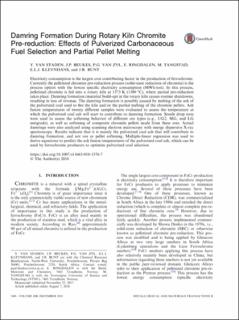| dc.contributor.author | van Staden, Yolindi | |
| dc.contributor.author | Beukes, Johan Paul | |
| dc.contributor.author | van Zyl, Pieter Gideon | |
| dc.contributor.author | Ringdalen, Eli | |
| dc.contributor.author | Tangstad, Merete | |
| dc.contributor.author | Kleynhans, Ernst L.J. | |
| dc.contributor.author | Bunt, John Reginald | |
| dc.date.accessioned | 2020-12-28T13:26:57Z | |
| dc.date.available | 2020-12-28T13:26:57Z | |
| dc.date.created | 2018-10-11T14:22:32Z | |
| dc.date.issued | 2018 | |
| dc.identifier.citation | Metallurgical and materials transactions. B, process metallurgy and materials processing science. 2018, 1-16. | en_US |
| dc.identifier.issn | 1073-5615 | |
| dc.identifier.uri | https://hdl.handle.net/11250/2721027 | |
| dc.description.abstract | Electricity consumption is the largest cost contributing factor in the production of ferrochrome. Currently the pelletized chromite pre-reduction process (solid-state reduction of chromite) is the process option with the lowest specific electricity consumption (MWh/ton). In this process, pelletized chromite is fed into a rotary kiln at 1573 K (1300 °C), where partial pre-reduction takes place. Damring formation (material build-up) in the rotary kiln causes routine shutdowns, resulting in loss of revenue. The damring formation is possibly caused by melting of the ash of the pulverized coal used to fire the kiln and/or the partial melting of the chromite pellets. Ash fusion temperatures of twenty different samples were evaluated to assess the temperature at which the pulverized coal ash will start to contribute to damring formation. Sessile drop tests were used to assess the softening behavior of different ore types (e.g., UG2, MG, and LG metgrade), as well as softening of composite chromite pellets made from these ores. Actual damrings were also analyzed using scanning electron microscopy with energy dispersive X-ray spectroscopy. Results indicate that it is mainly the pulverized coal ash that will contribute to damring formation, and not ore or pellet softening. Multiple-linear regression was used to derive equations to predict the ash fusion temperatures of the pulverized coal ash, which can be used by ferrochrome producers to optimize pulverized coal selection. | en_US |
| dc.language.iso | eng | en_US |
| dc.publisher | Springer | en_US |
| dc.rights | Navngivelse 4.0 Internasjonal | * |
| dc.rights.uri | http://creativecommons.org/licenses/by/4.0/deed.no | * |
| dc.title | Damring formation during rotary kiln chromite pre-reduction: Effects of pulverized carbonaceous fuel selection and partial pellet melting | en_US |
| dc.type | Peer reviewed | en_US |
| dc.type | Journal article | en_US |
| dc.description.version | publishedVersion | en_US |
| dc.rights.holder | © The Author(s) 2018 Open Access This article is distributed under the terms of the Creative Commons Attribution 4.0 International License (http://creativecommons.org/licenses/by/4.0/), which permits unrestricted use, distribution, and reproduction in any medium, provided you give appropriate credit to the original author(s) and the source, provide a link to the Creative Commons license, and indicate if changes were made. | en_US |
| dc.source.pagenumber | 3488–3503 | en_US |
| dc.source.volume | 49 | en_US |
| dc.source.journal | Metallurgical and materials transactions. B, process metallurgy and materials processing science | en_US |
| dc.identifier.doi | 10.1007/s11663-018-1376-7 | |
| dc.identifier.cristin | 1619725 | |
| cristin.unitcode | 7401,80,63,0 | |
| cristin.unitname | Metallproduksjon og prosessering | |
| cristin.ispublished | true | |
| cristin.fulltext | original | |
| cristin.qualitycode | 2 | |

